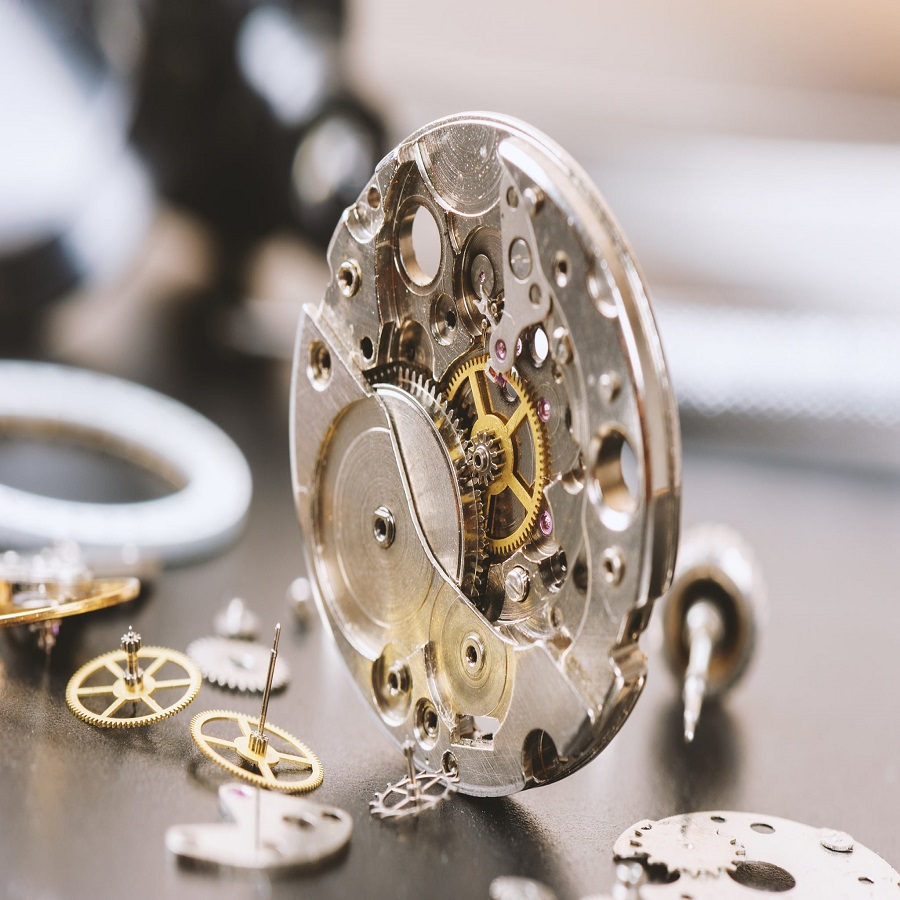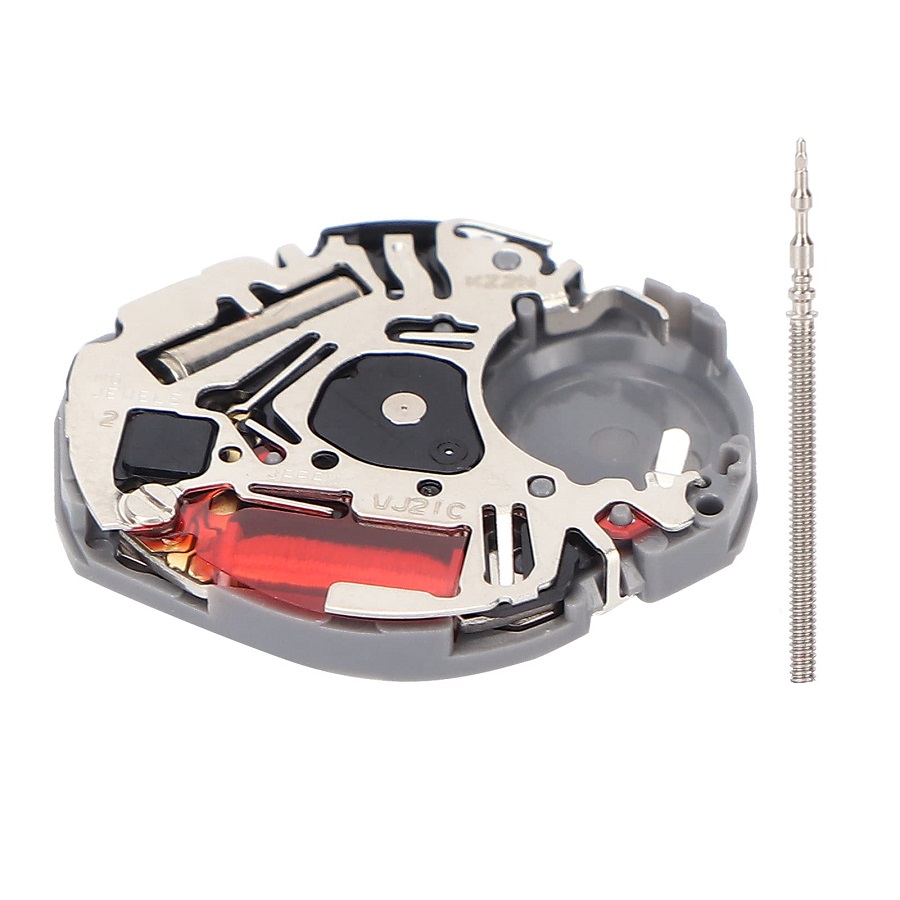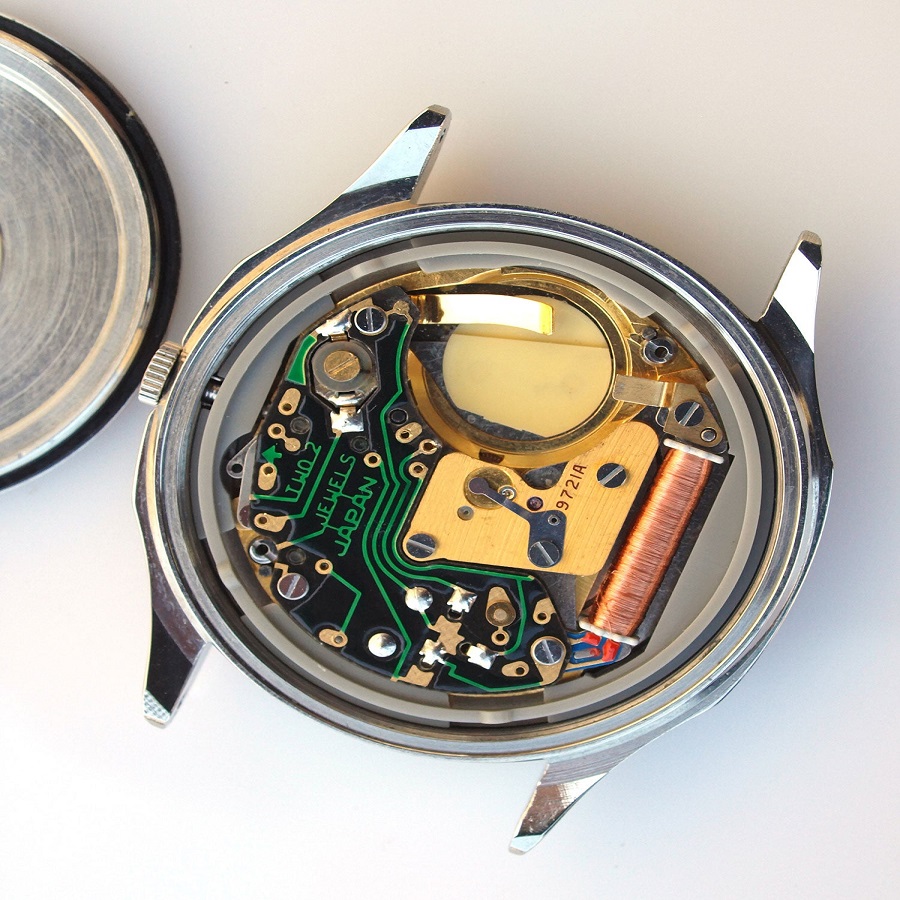What is a Quartz Watch Movement?
A quartz watch movement is the powerhouse behind a quartz watch’s precision. It relies on a tiny piece of quartz crystal to keep time accurately. When an electric current, from a small battery, passes through this crystal, it vibrates at a constant frequency. This vibration is what drives the timekeeping mechanism of the watch.
Unlike mechanical watches, which need winding, quartz watches use this battery-powered electronic circuit. This circuit controls the quartz crystal’s oscillations and powers the watch hands or digital display. Quartz movements are known for their reliability and accuracy, often losing just seconds per month. They require minimal maintenance aside from battery replacements, making them popular among watch wearers.
With simpler construction than complex mechanical movements, quartz movements allow for slimmer, more affordable watch designs. They stand as a testament to innovation in timekeeping technology.
The quartz watch movement has been a game-changer since its introduction in the late 20th century. It has made precise timekeeping accessible to a wider audience. Today, these movements continue to be at the heart of many timepieces, from economical models to luxury watches.
 The History of Quartz Watch Technology
The History of Quartz Watch Technology
The history of quartz watch technology is a tale of innovation and precision. The journey began in the 1920s when the first quartz crystal oscillator was developed. However, it was not until the 1960s that the first quartz wristwatch made its debut. This breakthrough was revolutionary. It marked the beginning of the quartz revolution in the world of watches.
In 1969, the release of the Seiko Astron changed everything. It was the first commercially available quartz wristwatch. Its introduction signaled a new era in timekeeping. The Seiko Astron boasted unparalleled accuracy compared to its mechanical counterparts. This sparked a surge in popularity for quartz watches. By the 1970s, the Quartz Crisis had begun. Traditional watchmaking industry felt the impact as quartz technology took the market by storm.
The Quartz Crisis pushed the Swiss watch industry to adapt and innovate. Swiss companies eventually embraced quartz technology, leading to the Swiss Quartz Revolution. This period saw the creation of thinner, more energy-efficient, and more accurate quartz movements.
The 1980s and 1990s saw quartz movements becoming the standard in the watch industry. These decades witnessed the proliferation of affordable, reliable, and accurate timepieces. Today, quartz watch technology remains integral to the watch industry. It has allowed for diverse designs and capabilities in both digital and analog formats.
The simplicity and lower cost of quartz movements have made precision timekeeping widely available. They have democratized the ownership of accurate watches. Indeed, the history of quartz watch movement is not just about technology. It’s about the transformation of how we perceive and value time itself.
How Quartz Movements Maintain Accurate Time
Quartz watch movements ensure precision in a simple yet effective way. A battery sends a current through a quartz crystal, causing it to vibrate. These vibrations happen 32,768 times per second, a steady rate. A circuit monitors these oscillations and converts them into regular electric pulses. These pulses drive the motor that moves the watch hands or powers the digital display.
To keep time accurately, quartz movements use these consistent vibrations of the crystal. Because the vibrations are so stable, the time shown is extremely precise. Even when temperatures change, the quartz crystal maintains its regular rhythm. This reliability means a quartz watch may only lose a few seconds per month. Such accuracy surpasses that of a mechanical watch, which can vary more in timekeeping.
Moreover, quartz movements are less affected by external factors like gravity and position. Mechanical watches, by contrast, may need adjusting based on the wearer’s movements. This makes quartz watches more suitable for everyday wear, without the worry of constant time adjustments or maintenance.
Comparing Quartz with Mechanical and Automatic Movements
When shopping for a watch, you’ll often come across the terms quartz, mechanical, and automatic. Understanding the differences between these movements is crucial for choosing the right watch for your needs. Let’s break down the key distinctions.
Firstly, quartz movements boast superior accuracy. They are battery-powered, leading to few seconds of loss each month. Mechanical movements, in contrast, require manual winding. Precision can vary with daily wear. Automatic movements self-wind as you move. They also face accuracy fluctuations, similar to mechanical watches.
Quartz movements stand out for their minimal maintenance. They rarely need more than a battery change. Mechanical watches demand regular winding and servicing. Automatic watches need less attention but still more than quartz.
In terms of craftsmanship, mechanical and automatic watches shine. Watch enthusiasts often prize the intricate engineering and heritage of their movement’s. Quartz movements are less complex, making them more affordable.
For those seeking a practical, reliable timepiece, quartz movements are a solid choice. If you value tradition and the art of watchmaking, you might lean towards mechanical or automatic options. Each type has its place in the world of watches, fulfilling different desires and needs.
The Components of a Quartz Movement
The quartz watch movement, while less intricate than mechanical counterparts, consists of several key components working in unison to deliver its hallmark accuracy. At its core is the quartz crystal, which, when energized by the watch’s battery, vibrates at a remarkably stable frequency. These vibrations are the heartbeat of the timepiece, ensuring consistent time measurement.
Another vital component is the integrated circuit. This tiny but powerful device counts the crystal’s vibrations and translates them into electrical pulses at regular intervals. These pulses are then used to generate the precise movement of the watch hands or the digital display, depending on the type of quartz watch.
The stepping motor plays a crucial role as well. It reacts to the electrical pulses from the integrated circuit, engaging gears that move the watch hands forward in precise, controlled steps. This precision is what allows quartz watches to maintain near-perfect time over long periods.
Lastly, the battery is the unsung hero of the quartz movement, providing the consistent electrical current that powers the entire process. It’s the battery that needs occasional replacing, which is the primary maintenance the quartz movement requires.
Together, these components form a reliable and low-maintenance timekeeping module that has revolutionized the watch industry. Simplified construction not only leads to fewer points of failure but also allows for a range of watch designs that are both practical and accessible.
Maintenance and Care for Quartz Watches
Despite the robustness and reliability of quartz watch movements, proper maintenance is essential to ensure optimal performance. Here are some straightforward steps to take care of your quartz timepiece:
- Battery Replacement: The battery is the lifeline of a quartz watch. Typically, it requires changing every 1 to 2 years, but always consult your watch’s manual for specific guidelines. A dying battery can leak and damage the internal components, so timely replacement is vital.
- Cleanliness is Key: Regularly clean your watch with a soft, dry cloth to remove dust and perspiration. For tougher grime, use a damp cloth with mild soap, avoiding the watch dial and case back to prevent water damage.
- Water Resistance Check: If your quartz watch is water-resistant, have it checked annually by a professional. This ensures that the seals are intact and the watch can withstand exposure to moisture as intended.
- Avoid Magnetic Fields: Keep your watch away from strong magnetic fields which can affect the accuracy of the quartz movement. Items like speakers, refrigerators, and certain electronic devices can emit such fields.
- Professional Servicing: Beyond battery replacements, it’s wise to have your watch checked every few years by a professional. They can inspect the movement, re-lubricate if necessary, and ensure the timekeeping remains precise.
Remember, while quartz watches are praised for their minimal upkeep, paying attention to these details will extend the lifespan and maintain the precision of your valued timepiece.
The Impact of Quartz Movements on the Watch Industry
Quartz watch movements have transformed the watch industry. Their introduction in the late 20th century disrupted traditional watchmaking. With their high accuracy and low maintenance, quartz watches became an instant hit. They challenged the dominance of mechanical and automatic movements. This led to what is known as the Quartz Crisis or Quartz Revolution.
The effect on the industry was profound. Quartz technology forced the Swiss watch industry, long revered for mechanical precision, to innovate. Affordable and reliable, quartz watches quickly filled the market. This spurred established brands to develop their own quartz lines. The result was a broader range of choices for consumers.
The adoption of quartz movements democratized precision timekeeping. It allowed for thinner, more streamlined watch designs. These movements cater to a wider audience, with different tastes and budgets. While collectors and enthusiasts might prefer mechanical pieces, quartz appeals to the everyday wearer.
The industry itself had to adapt. Manufacturing processes evolved to accommodate the simpler construction of quartz mechanisms. This shift resulted in cost reductions and a change in labor skills. The emphasis moved from intricate craftsmanship to technological innovation.
The reliability of quartz movements has shaped consumer expectations. Durability and accuracy have become standard demands. The wide reach of quartz watches has accentuated the need for such features in all timepieces.
In conclusion, quartz movements have had a lasting impact on the watch industry. They remain central to watch production and design. This innovation has shaped the way watches are made, sold, and enjoyed across the globe.
Future Trends in Quartz Watch Movements
As watchmakers continue to innovate, the future of quartz watch movements looks promising. Here are some foreseeable trends:
- Increased Precision: Efforts to enhance the precision of quartz movements are ongoing. Expect advancements that could further reduce the already minimal time loss per month.
- Improved Power Efficiency: Watchmakers are researching ways to extend battery life. Newer, more efficient batteries could lead to even longer intervals between replacements.
- Integrated Smart Technology: The rise of smartwatches has begun a trend of incorporating connectivity and smart features into quartz watches. This blend offers precision timing with modern tech perks.
- Eco-Friendly Innovations: There’s a growing interest in sustainable watchmaking. Future quartz movements may use solar power or other green energy sources, reducing environmental impact.
- Design Innovations: The simplicity of quartz movements allows for slim and sleek designs. We can expect more innovative watch designs that push the boundaries of style.
- Customizable Options: Personalization is becoming important to consumers. Quartz watches may offer more customizable features in face designs, materials, and functionality.
Quartz watch movements, with their precision and reliability, have reshaped the industry. As we look to the future, they will continue to adapt, offering new features and improvements that meet the evolving demands of watch enthusiasts around the world.

